We reveal the secrets of the test lab F-Center
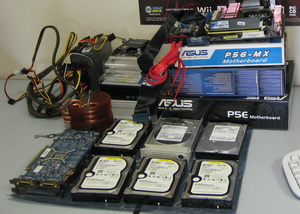 Recently, I was unexpectedly invited to an excursion to the F-Center test lab. Not for the first year I have been reading their section with articles, because in RuNet there are quite a few intelligent, technically competent sites about hardware. For this reason, sometimes I correspond with the authors and often refer to them in the blog and on Habré. And then there was an opportunity to see everything with my own eyes and even take a picture.
Recently, I was unexpectedly invited to an excursion to the F-Center test lab. Not for the first year I have been reading their section with articles, because in RuNet there are quite a few intelligent, technically competent sites about hardware. For this reason, sometimes I correspond with the authors and often refer to them in the blog and on Habré. And then there was an opportunity to see everything with my own eyes and even take a picture.Oleg Artamonov, the author and editor of articles on iron, met me in the trading hall on Sukhonskaya and invited me to the office premises.
The overall impression was as I expected - a quiet and comfortable office of a couple of rooms, lined with test benches, measuring devices and various pieces of hardware that arrived for testing. Jobs correspond to the topics of the articles of the authors. Someone has all kinds of drives, someone has monitors or power supplies. The constant turnover of the "exhibits" does not make it possible to arrange everything permanently, therefore there is an element of creative disorder, but within reasonable limits (below will be a photo).
')
In principle, no one is testing anything yet, and you don’t see much, so we mainly talked with the authors.
Oleg often tests monitors and writes articles in the appropriate section . I have long wanted to look at the calibration process, so I asked to show it. The fact is that without accurate calibration, many monitors are initially set up very badly, so you can see a noticeable difference in the color rendition before and after the procedure. Calibrators are expensive heaped and cheap unpretentious. Prices start at $ 60-70, and basically this is the cost of the proprietary software included. Very cheap models can give not very high-quality results, so it is better to investigate the issue when choosing a calibrator. Some professional monitors, such as the NEC UXi, include a calibrator in the package. The principle of its operation is quite simple. The calibrator is hung on the screen, tightly clinging to its surface so that there are no gaps for the penetration of light. Then, a calibration utility is launched, which sequentially fills the screen with predefined colors, and the calibrator checks the color rendition for "truth" at this time. At the end of the work, a color profile is created (a file with the ics extension), which is then loaded by the video card driver and subsequently the color temperature is adjusted for it. On some monitors, the color profile can be saved in the monitor itself, but this is quite rare for expensive models. When linking a profile to a driver, it is often necessary to sacrifice non-Windows systems, although in Linux the task is also somehow solvable.
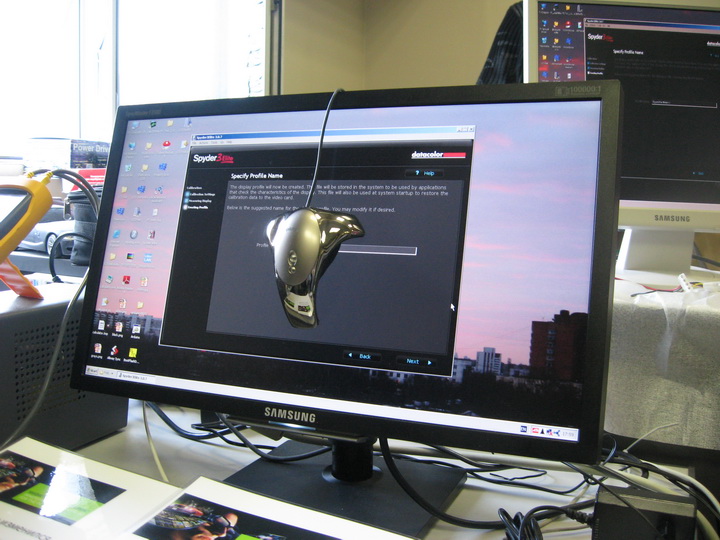
Talk about calibration has been delayed. Oleg told about the procedure for color calibration of printers, cameras and applications such as Adobe Photoshop. Without accurate and, most importantly, synchronous settings for the listed devices and applications, it will be quite difficult to correct and print photos correctly so that they look the same on the screen and on photo paper.

Among other interesting things monitors managed to see how the new Samsung SyncMaster 2233RZ works with a scan rate of 120 Hz.
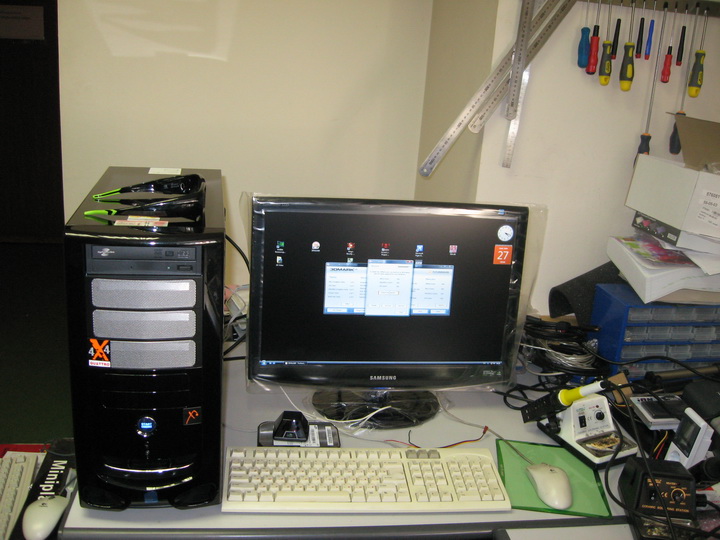
Detailed article is on the website of the company. Unexpectedly pleasant was the fact that the usual movement of windows on the screen at a frequency of 120 Hz is much smoother. Before that, I had no doubt that modern video cards provide the smoothest possible movement, although they were confused by strange jerks. Here the smoothness immediately catches the eye, and the reason for the jerks becomes clear. Specially compared with the normal mode of 60 Hz on the same monitor.
Also saw a pre-production sample of a very interesting monitor Samsung F2080 , which has already entered the market. VA matrix, 20 ″, 1600 × 900 (this is it in the photo with the calibrator above). The key point here is a good matrix at a rather low price. I am glad that the complete domination of TN is so far avoided. The monitor was expected to be very cheap, but you can buy it from us for at least $ 400, which, however, is not bad either. By the way, judging by the note on TFT Central, this is not sPVA, but a cheaper cPVA matrix.
I also asked about the mysterious e-IPS matrix in the Dell 2209WA. This is really a cheaper option for S-IPS. Another joy in the camp of non-admirers of TN.
By the way, about the Dell monitors . The company's pricing policy is such that it is very disadvantageous to transport monitors to Russia, therefore, according to Oleg, the majority of inexpensive Dell monitors can be gray in our country, i.e. imported under questionable schemes. But this doesn’t bother me for a year to enjoy the quality of the Dell 2408 WFP :)
Next, we moved to a corner where power supplies are tested . Quite an interesting stand for connecting various kinds of loads in order to squeeze out the maximum from the power supply unit and at the same time check the noise level and fan speed.

Unfortunately, the noise level is assessed just by ear, which is clearly stated in the articles when it is written about “very low noise”. Measurements in decibels are certainly important, but this is, strictly speaking, a rather difficult task with a total noise background of around 20 dB. So do on iXBT, so if you need numbers - you can see among their articles.
At the same time they have a soundproofing chamber , although it is used for some other purposes.
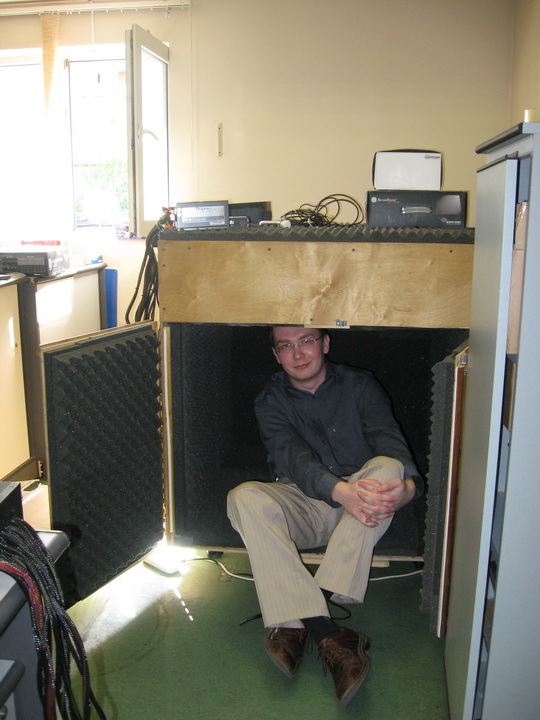
It was possible to take a live look at the board for measuring the power consumed by the system unit. I gave a link to the article recently. Designed a board and wrote the necessary software Oleg. The result is a valuable laboratory instrument.

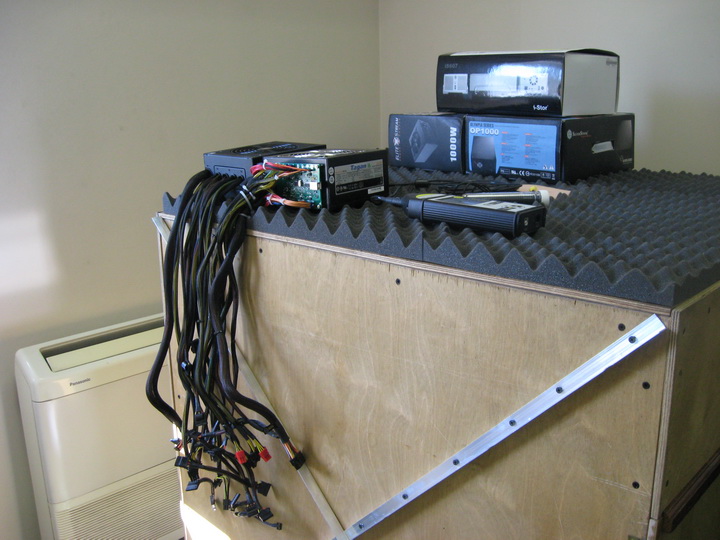
And, thanks to the data on energy consumption, we managed to easily assemble a powerful system unit on the Core i7 and the top NVIDIA graphics card in a very small package with a standard power supply.

I have long been interested in the conditions under which the manufacturer provides samples of equipment for testing. It turned out that it strongly depends on the manufacturer itself and on the attendance of the resource on which the review is supposed, and on some other things. The device may be asked to return, or they may not. They may be asked to preserve the presentation, or they may give free rein to disassemble it into small screws. Usually, the pre-production batch diverges among the leading publishers, and what remains remains smaller.
With Oleg, we still talked about the heating processors . I once wrote a note that various utilities can show very different processor temperatures. It is not a matter of program errors, but that either the core temperature or the temperature of a certain sensor located on the motherboard or somewhere else can be measured. And the readings can be very different - almost by 50%. So choose the right utility.
We talked a little about the problem of charging batteries . The fact is that the F-Center has repeatedly conducted tests of the quality of batteries and batteries, as well as their endurance in the cold. The articles mentioned high-quality charger Sanyo. I used to think that this was not a matter of principle, but then I consistently died 3 pairs of batteries, which I charged with a simple GP. Chargers that support installing batteries only 2 or 4 each are not worth buying because they stop charging when one of the two batteries in a pair is charged. The second one loses its charge and loses its capacity very quickly. This contributes to the uneven battery consumption in cameras and other devices. Therefore, it is recommended to buy chargers with fully independent channels in which you can charge both 1 and 3 batteries. Each channel is turned off only when the battery is fully charged, inserted into it. There are also models with the function of “training” of batteries - they can spend several charge-discharge cycles for a new battery in order to achieve maximum capacity. But such devices are already from 2000 rubles.
Then we managed to see a stand on testing hard drives . This area is managed by another author. As you can see, the preparation of a comparative review is not easy.

Note that the Enermax Modu 82+ is used here as the PSU (and not only here). I have long recommended it to everyone as a completely silent unit. Wandering through the laboratory, I noticed samples of the next generation block 85+, which, judging by the marking, should be even more efficient in efficiency.
A scattering of once-tested drives, which for one reason or another have settled in the laboratory, also looks funny. Someone could not stand the test, someone just turned out to be not claimed by the supplier.

But in these buildings with a bunch of propellers installed several disks of 15-thousanders .

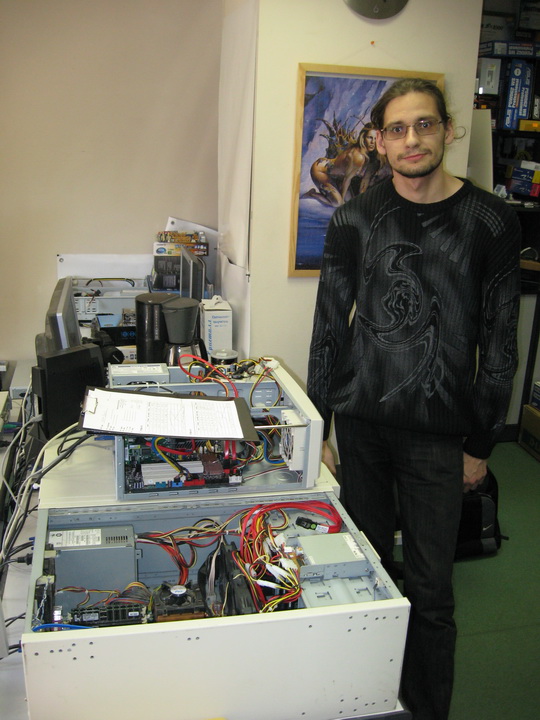
I saw an interesting experimental device - a drive assembled on rails of RAM . Unfortunately, I forgot to take a photo.
I liked this dock for disks .
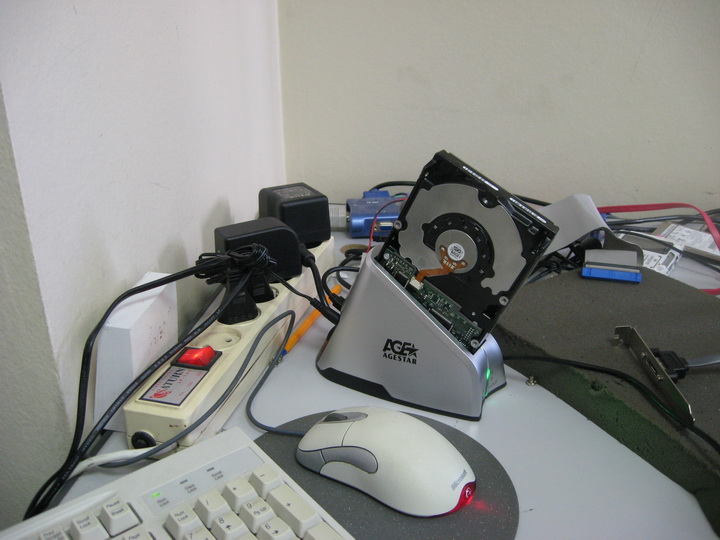
SATA drives can be inserted and pulled out directly on a running system (the interface supports hot swap). If you do everything carefully, then no problems with loosening the contacts should arise.
But such a camera is used to test the temperature conditions of the devices and for various experiments with overclocking, which I do n’t like so much :)

At the time of the tour, the camera was used for its intended purpose - the storage of chilled beverages, which is more important in the summer.
In general, the team of authors really liked. Conversations and laboratory inspection left an impression of excellence. People love their work and do it with pleasure. I want to thank for the interesting excursion and I wish to continue to keep the quality bar.
Source: https://habr.com/ru/post/62266/
All Articles